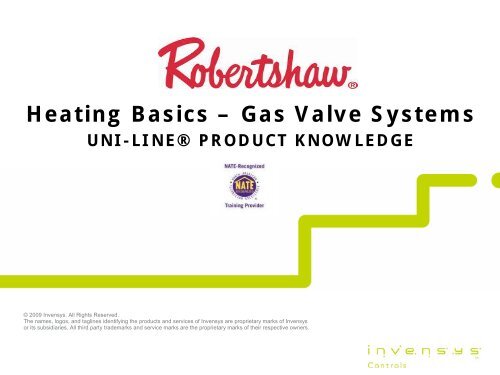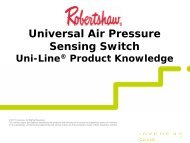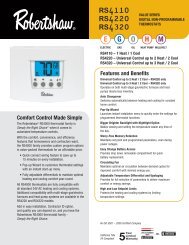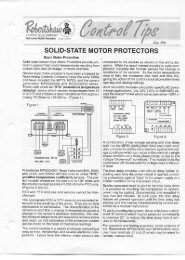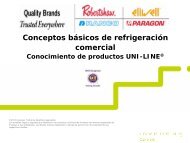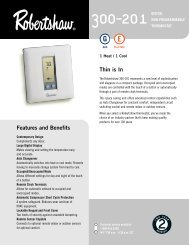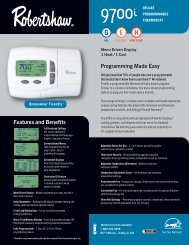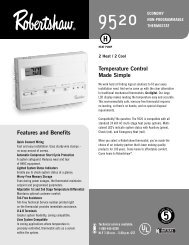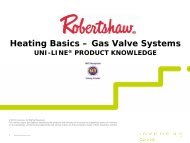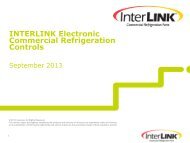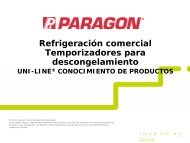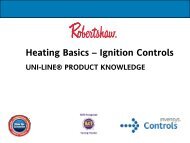Heating Basics â Gas Valve Systems - Robertshaw Thermostats
Heating Basics â Gas Valve Systems - Robertshaw Thermostats
Heating Basics â Gas Valve Systems - Robertshaw Thermostats
Create successful ePaper yourself
Turn your PDF publications into a flip-book with our unique Google optimized e-Paper software.
<strong>Heating</strong> <strong>Basics</strong> – <strong>Gas</strong> <strong>Valve</strong> <strong>Systems</strong><br />
UNI-LINE® PRODUCT KNOWLEDGE<br />
© 2009 Invensys. All Rights Reserved.<br />
The names, logos, and taglines identifying the products and services of Invensys are proprietary marks of Invensys<br />
or its subsidiaries. All third party trademarks and service marks are the proprietary marks of their respective owners.
Subjects We Will Cover In This Session<br />
• Fuel and Pressure Characteristics<br />
• NFPA 54 National Fuel <strong>Gas</strong> Code<br />
• <strong>Gas</strong> <strong>Valve</strong> Applications<br />
• <strong>Gas</strong> <strong>Valve</strong> Actuator Types<br />
• <strong>Gas</strong> <strong>Valve</strong> Characteristics<br />
• <strong>Gas</strong> <strong>Valve</strong> Manufacturers<br />
• Ignition Control System<br />
• Ignition Manufacturers<br />
• Flame Rectification<br />
• Pilot <strong>Basics</strong><br />
• Thermocouple and Thermopile <strong>Basics</strong><br />
• Installation and Troubleshooting Tips<br />
• Website Tools<br />
• When You Have Questions<br />
• Q&A
Acronyms<br />
BTU = British Thermal Units<br />
LC = Low Capacity<br />
LP = Liquid Propane<br />
MV = Main <strong>Valve</strong><br />
NAT = Natural <strong>Gas</strong><br />
PD = Pressure Drop<br />
PV = Pilot <strong>Valve</strong><br />
SLC = Snap-action Low Capacity<br />
mV = milliVolts<br />
WC = Water Column
Fuel Characteristics<br />
Natural <strong>Gas</strong> Characteristics Liquid Propane<br />
(LP)<br />
0.64 Specific Gravity 1.53<br />
1000 BTUs / Cubic Feet 2500<br />
7”WC – 10.5”WC<br />
Service Pressure<br />
Range<br />
11”WC – 14”WC<br />
1200º F Ignition Temperature 950º F<br />
10/1 Combustion<br />
24/1<br />
Air/<strong>Gas</strong> Ratio<br />
• Natural gas is lighter than air and rises<br />
• L.P. gas is heavier and puddles in the lowest area it can find
Fuel Characteristics of British Thermal<br />
Units<br />
• Definition of BTU: The quantity of heat required to raise the<br />
temperature of one pound of water one degree Fahrenheit<br />
• Many gas appliances are rated depending on BTU output<br />
• The more heat needed, the higher the BTU rating<br />
• Residential gas water heaters (regardless of fuel) are rated between<br />
15,000 and 75,000 BTU<br />
• Over 75,000 BTU is considered Commercial Water Heater<br />
• Commercial Water Heaters rated between 75,000 and 750,000 BTU
Pressure Characteristics<br />
Pressure Side Natural <strong>Gas</strong> Liquid Propane<br />
Inlet Pressure 7” – 10” WC 14” – 17” WC<br />
Outlet Pressure 3” – 4” WC @ 1” PD 10” – 11” WC @ 1” PD<br />
• Excessive inlet pressure will not necessarily cause the gas valve to lock up<br />
– However, the valve will not regulate pressure correctly<br />
• <strong>Gas</strong> line pressure from utilities vary seasonally with demand<br />
– During peak usage, inlet pressure can drop below the 7” WC Natural gas shown above<br />
• High rise buildings may experience low pressure on upper floors<br />
– Especially during cold weather, many times a 2 psig system is used to compensate<br />
• In some instances OEMs will specify higher outlet pressures<br />
– To obtain BTU rates beyond the capabilities of the gas valve at 1” pressure drop
NFPA 54 National Fuel <strong>Gas</strong> Code<br />
• Issued initially in 1974, reviewed June 2008 version<br />
• <strong>Gas</strong> code based on requirements from:<br />
– American <strong>Gas</strong> Association<br />
– American National Standard Installation of <strong>Gas</strong> Appliances and <strong>Gas</strong> Piping<br />
• (ANSI Z21.30)<br />
– Installation of <strong>Gas</strong> Piping and <strong>Gas</strong> Equipment on Industrial Premises<br />
• (ANSI Z83.1)<br />
– Fuel <strong>Gas</strong> Piping<br />
• (ASME B31.2)<br />
• More information can be obtained from www.nfpa.org
NFPA 54 Fuel <strong>Gas</strong> Code Table
Central <strong>Heating</strong> Applications<br />
Factory Model<br />
BTU @ 1” PD Min - Max BTU Capacity Standing Intermittent Direct<br />
(Uni-Line ® Part)<br />
7000 STD<br />
(Uni-Line 700)<br />
7000 HC<br />
(Uni-Line 700)<br />
7200<br />
(Uni-Line 720)<br />
Nat 300,000 10,000 – 720,000 <br />
LP 485,000 10,000 – 900,000 <br />
Nat 600,000 200,000 – 800,000 <br />
LP 972,000 300,000-1,150,000 <br />
Nat 150,000 15,000 – 200,000 <br />
LP 240,000 15,000 – 320,000
Space <strong>Heating</strong> And Hearth Applications<br />
Factory Model BTU @ 1” PD Min - Max BTU Capacity Standing Intermittent Direct<br />
7000 STD<br />
(Uni-Line 700)<br />
7200<br />
(Uni-Line 720)<br />
2000<br />
(Uni-Line 722)<br />
7500<br />
(Uni-Line 722)<br />
7000 LC<br />
(Uni-Line 710)<br />
7000 ST<br />
(Uni-Line 700)<br />
Nat 300,000 10,000 – 720,000 <br />
LP 485,000 10,000 – 900,000 <br />
Nat 150,000 15,000 – 200,000 <br />
LP 240,000 15,000 – 320,000 <br />
Nat 125,000 25,000 – 170,000 <br />
LP 200,000 25,000 – 272,000 <br />
Nat 100,000 6,700 – 160,000 <br />
LP 162,000 6,700 – 226,000 <br />
Nat 40,000 5,000 – 70,000 <br />
LP 65,000 5,000 – 100,000 <br />
Nat 100,000 10,000 – 160,000 <br />
LP 162,000 10,000 – 225,000
Commercial Water <strong>Heating</strong> Applications<br />
Factory Model BTU @ 1” PD Min - Max BTU Capacity Standing Intermittent Direct<br />
7000 STD<br />
Nat 300,000 10,000 – 720,000 <br />
(Uni-Line 700)<br />
LP 485,000 10,000 – 900,000 <br />
7200<br />
Nat 150,000 15,000 – 200,000 <br />
(Uni-Line 720)<br />
LP 240,000 15,000 – 320,000 <br />
2000<br />
Nat 125,000 25,000 – 170,000 <br />
(Uni-Line 722)<br />
LP 200,000 25,000 – 272,000 <br />
7000 HC<br />
Nat 600,000 200,000 – 800,000 <br />
(Uni-Line 700)<br />
LP 972,000 300,000 – 1,150,000
Commercial Cooking Applications<br />
Factory Model BTU @ 1” PD Min - Max BTU Capacity Standing Intermittent Direct Temp Rating<br />
7000 STD<br />
(Uni-Line 700)<br />
7200<br />
(Uni-Line 720)<br />
2000<br />
(Uni-Line 722)<br />
7500<br />
(Uni-Line 722)<br />
7000 LC<br />
(Uni-Line 710)<br />
TS11 J &K<br />
(Uni-Line 700)<br />
Nat 300,000 10,000 – 720,000 <br />
LP 485,000 10,000 – 900,000 <br />
Nat 150,000 15,000 – 200,000 <br />
LP 240,000 15,000 – 320,000 <br />
Nat 125,000 25,000 – 170,000 <br />
LP 200,000 25,000 – 272,000 <br />
Nat 100,000 6,700 – 160,000 <br />
LP 162,000 12,000 – 226,000 <br />
Nat 40,000 5,000 – 70,000 <br />
LP 65,000 5,000 – 100,000 <br />
Nat 210,000 NA <br />
LP 340,000 NA <br />
-40 to 175ºF<br />
-40 to 175ºF<br />
-40 to 175ºF<br />
0 to 185ºF<br />
-40 to 225ºF<br />
32 to 300ºF
Residential Water <strong>Heating</strong> Applications<br />
Factory Model BTU @ 1” PD Min - Max BTU Capacity Standing Intermittent Direct Temp Rating<br />
220R<br />
(Uni-Line 110)<br />
Nat 86,000 10,700 – 107,000 <br />
LP 100,000 7,000 – 140,000 <br />
32 to 175ºF<br />
R103RV<br />
(Uni-Line 110)<br />
Nat NA NA <br />
LP > 35,000 3,500 – 35,000 <br />
32 to 175ºF<br />
2000<br />
(Uni-Line 722)<br />
Nat 125,000 25,000 – 170,000 <br />
LP 200,000 25,000 – 272,000 <br />
-40 to 175ºF<br />
R110R<br />
(Uni-Line 110)<br />
Nat 86,000 10,700 – 107,000 <br />
LP 100,000 7,000 – 140,000 <br />
32 to 175ºF
<strong>Gas</strong> <strong>Valve</strong> Actuator Types<br />
• Manual – Standing pilot valve manually turned ON and OFF<br />
for each heating cycle.<br />
• Millivolt – Wall thermostat actuated with manual gas cock,<br />
automatic pilot safety valve and a Millivolt operator. The<br />
automatic pilot safety is separate from gas cock and provides<br />
shutoff in case of pilot outage. Millivolt gas valves do not<br />
require external power source.<br />
• 24 Volt, 120 Volt, and 240 Volt – Combines a manual main<br />
and pilot gas valve, a separate automatic safety pilot valve,<br />
pilot filtration, and automatic electric valve.<br />
• Hydraulic – Temperature is sensed by a capillary bulb. The<br />
bulb in the return air stream is actuated open and close by<br />
the hydraulic system.
Millivolt Actuated <strong>Gas</strong> <strong>Valve</strong><br />
Wall Thermostat<br />
<strong>Gas</strong> Cock<br />
ECO<br />
(Limit)<br />
Safety<br />
Operator<br />
Pilot Line ⇒<br />
Pilot and<br />
Thermopile
<strong>Robertshaw</strong> ® 700 & 710 Millivolt Wiring<br />
R<br />
W<br />
Safety<br />
Magnet<br />
OPERATOR<br />
TH/TP<br />
TP<br />
TH<br />
1950 Series<br />
Two-Lead<br />
Thermopile<br />
Safety<br />
Magnet<br />
OPERATOR<br />
R<br />
W<br />
TH/TP<br />
TP<br />
TH<br />
1951 Series<br />
Coaxial<br />
Thermopile
24 Volt Actuated – Standing Pilot System<br />
Most popular Uni-Line ® part is 710-402, Factory Part 7000-ERLC<br />
Wall Thermostat<br />
24 VAC<br />
120 VAC<br />
Transformer<br />
ECO<br />
(Limit)<br />
<strong>Gas</strong> Cock<br />
High Limit NC<br />
Operator<br />
Fan Control NO<br />
Fan<br />
Motor<br />
Pilot and<br />
Thermocouple
Hydraulic Actuated – Standing Pilot System<br />
56F LO 1 2 3 4 5 6 7 8 HI 90F<br />
ECO<br />
(Limit)<br />
<strong>Gas</strong> Cock<br />
Temperature<br />
Control Knob<br />
Sensing Bulb<br />
Safety<br />
Pilot and<br />
Thermocouple
Additional <strong>Gas</strong> <strong>Valve</strong> Characteristics<br />
• Combination <strong>Gas</strong> <strong>Valve</strong>s<br />
• Open <strong>Valve</strong> Options<br />
– Standard Opening<br />
– Slow Opening<br />
– Step Opening<br />
– Two-stage Models<br />
• Close <strong>Valve</strong> Options<br />
– Snap Action<br />
– Snap Throttle
Combination <strong>Gas</strong> <strong>Valve</strong>s<br />
Combination valves include three components<br />
• Regulation<br />
• Safety valve<br />
• Main valve actuated by thermostat or bulb
Additional <strong>Gas</strong> <strong>Valve</strong> Characteristics<br />
<strong>Robertshaw</strong>® <strong>Gas</strong> <strong>Valve</strong> Opening Characteristics<br />
LEGEND<br />
450,000<br />
OPENING CHARACTERISTICS<br />
400,000<br />
350,000<br />
STANDARD OPEN<br />
BTU<br />
300,000<br />
250,000<br />
200,000<br />
150,000<br />
100,000<br />
Standard Open<br />
Slow Open<br />
Step Open<br />
instant full flow<br />
SLOW OPEN<br />
S7A = 0 - 5 sec. to full flow<br />
50,000<br />
0<br />
0 1 5 10 15 20 25 30 35 40<br />
S7B = 5 - 10 sec. to full flow<br />
S7C = 10 - 30 sec. to full flow<br />
Time (s)<br />
STEP OPEN<br />
SO1 = 30% of full flow<br />
SO2 = 40% of full flow<br />
SO3 = 50% of full flow<br />
SO4 = 60% of full flow
Additional Characteristics for Two-Stage<br />
• <strong>Robertshaw</strong> ® two-stage gas valves use a two-stage, two-pressure<br />
regulator which responds to a two-stage controller (thermostat)<br />
• Available in capacities from 29,000 to 960,000 BTU/Hr<br />
• Piping sizes from 3/8 to 1 inch<br />
• Can be used with either natural gas or liquid propane<br />
• Two-stage has the ability to vary the gas pressure delivered to the<br />
main burner(s) through the use of a solenoid operated two-pressure<br />
regulator<br />
• First stage actuator of the gas valve is energized<br />
• When heat demand increases, the second stage regulator is<br />
energized<br />
• First stage setting is determined as a percentage of the full output<br />
of the valve and is factory set<br />
• Second stage pressure regulator setting is nominal 3.5” WC for<br />
natural gas and 11” for LP
Snap-Action And Snap-Throttle<br />
Hydraulic <strong>Valve</strong>s
<strong>Gas</strong> <strong>Valve</strong> Manufacturers<br />
Attributes <strong>Robertshaw</strong> ® Honeywell White-Rodgers Dexen SIT<br />
US Based Engineering <br />
US Based Technical Services <br />
Space & Central <br />
Residential Water <br />
Hearth Products <br />
Pilot, Thermocouple and<br />
Ignition Controls
Ignition Control <strong>Systems</strong><br />
• Standing Pilot<br />
• Intermittent Pilot Ignition (IPI)<br />
• Direct Spark Ignition (DSI)<br />
• Hot Surface Ignition (HSI)
Ignition <strong>Systems</strong><br />
Three Types of Ignition <strong>Systems</strong><br />
• Standing pilot – Pilot is manually ignited and stays on constantly. When<br />
the thermostat calls for heat, and the pilot flame is making good contact<br />
with the thermocouple, the gas valve allows gas to flow to main burner<br />
until the call for heat is satisfied. Least expensive, least efficient.<br />
• Intermittent pilot (also known as “spark to pilot”) – Pilot is ignited by a<br />
spark generated by an ignition module and electrode. When enough heat<br />
is generated in the thermocouple, the gas valve allows gas to the main<br />
burner and is ignited by the pilot until the call for heat is satisfied. More<br />
expensive, more efficient.<br />
• Direct spark and Hot Surface Ignition (HSI) – When the thermostat calls<br />
for heat, the main burner is ignited by a direct spark or ceramic (glow bar)<br />
igniter. Eliminates the pilot, but requires flame sensor and more expensive<br />
ignition module. Most expensive, most efficient.
Acronyms<br />
GRD = Ground<br />
IGN = Ignition<br />
LP = Liquid Propane<br />
MV = Main <strong>Valve</strong><br />
NO = Normally Open<br />
NC = Normally Closed<br />
PV = Pilot <strong>Valve</strong><br />
V AC = Voltage Alternating Current<br />
V DC = Voltage Direct Current
Definitions<br />
• Sensors - Senses the variable change in temperature and sends a<br />
signal to the controller.<br />
• Transmitters - Interprets signal from sensor to display condition of<br />
temperature variable.<br />
• Transformer - An electromagnetic device that either raises or<br />
lowers the voltage of an alternating current electrical system.<br />
• Voltage - The electrical potential pressure behind the flow of<br />
electricity, measured in terms of Volts.<br />
• Current - The movement of an electrical charge through a circuit,<br />
measured in terms of Amps.<br />
• Hertz - A unit of measurement for frequency in cycles per second of<br />
a waveform.<br />
• Relay - An electromechanical device that opens or closes contacts<br />
when a current is passed through a coil.
<strong>Gas</strong>es Used In Applications<br />
• Liquid Propane tends to hover at ground level<br />
• Natural <strong>Gas</strong> rises, goes up the flue<br />
• Manometer measures gas pressure<br />
– Inches of Water Column
Ignition Control System<br />
1. Thermostat calls for heat<br />
2. Ignition controller requests a spark to the electrode which ignites the gas<br />
3. Control uses flame rectification or sensor to identify if flame is present<br />
4. Ignition controller sends signal to open gas valve<br />
5. When thermostat is satisfied, gas valve closes to shut off main burner gas
Feature List for Ignition Controls<br />
• Approvals<br />
– CSA<br />
– UL<br />
• Ease of Use<br />
– Local vs. Remote Sensing<br />
•Some use Jumper<br />
– Diagnostic LEDs<br />
• Application Timings<br />
– Trial Attempts (1, 3, infinite)<br />
– Ignition Timing (seconds)<br />
– Pre/post/inter-purge settings<br />
• Physical<br />
– 24V AC @ 50 / 60 Hz<br />
– Surface Mount Technology (SMT)<br />
– Conformal coating<br />
– Installable in NEMA-3R boxes<br />
– Quick connects or plugs<br />
• Safety<br />
– Hard Lockout<br />
– Auto-Restart Lockout<br />
•Eliminates service calls
Pilot Ignition System<br />
ROBERTSHAW 780-745<br />
Ignition<br />
Control<br />
Module<br />
IGN<br />
FLAME<br />
SENSE<br />
PV<br />
GRD<br />
TR<br />
PV/MV<br />
TH<br />
MV<br />
U<br />
<strong>Valve</strong> Operator<br />
Terminals<br />
M C P<br />
24 VAC<br />
High<br />
Limit<br />
NC<br />
Transformer<br />
120 VAC<br />
Fan Control NO<br />
Pilot Line ⇒<br />
Pilot and<br />
Electrode /<br />
Sensor<br />
Fan<br />
Motor
Intermittent Pilot Checkout Procedure<br />
• Turn on main gas supply<br />
• Turn on manual gas valve<br />
• Turn on electrical power<br />
• Set thermostat to call for heat, spark begins<br />
ROBERTSHAW 780-745<br />
IGN<br />
FLAME<br />
SENSE<br />
PV<br />
GRD<br />
TR<br />
PV/MV<br />
TH<br />
MV<br />
Ignition<br />
Control<br />
Module<br />
U<br />
<strong>Valve</strong> Operator<br />
Terminals<br />
M C P<br />
Transformer<br />
24 VAC<br />
120 VAC<br />
High<br />
Limit<br />
NC<br />
Fan Control NO<br />
• Air purged from gas line<br />
Pilot Line ⇒<br />
Pilot and<br />
Electrode /<br />
Sensor<br />
Fan<br />
Motor<br />
• Pilot Ignition - main burner ignition<br />
• Turn manual gas valve off - burner & pilot go out<br />
• Sparking begins - turn manual valve on<br />
• Pilot ignites - main burner ignites
Intermittent Pilot Sequence of Operation<br />
• Thermostat calls for heat<br />
• Primary <strong>Valve</strong> (PV) opens<br />
• Pilot gas flows<br />
• Sparking begins at burner<br />
ROBERTSHAW780-745<br />
IGN<br />
FLAME<br />
SENSE<br />
PV<br />
GRD<br />
TR<br />
PV/MV<br />
TH<br />
MV<br />
Ignition<br />
Control<br />
Module<br />
U<br />
<strong>Valve</strong> Operator<br />
Terminals<br />
M C P<br />
Transformer<br />
24 VAC<br />
120 VAC<br />
High<br />
Limit<br />
NC<br />
Fan Control NO<br />
• Pilot gas ignites<br />
Pilot Line ⇒<br />
Pilot and<br />
Electrode /<br />
Sensor<br />
Fan<br />
Motor<br />
• Pilot flame impinges on electrode / sensor<br />
• Main gas valve (MV) opens<br />
• Main burner ignites<br />
• Once thermostat satisfied, switch contacts open<br />
• Main burner and pilot off
Hot Surface Ignition (HSI)<br />
ROBERTSHAW HS780<br />
TH<br />
VALVE<br />
GND<br />
TR<br />
RS<br />
120<br />
IGN<br />
IGN<br />
NEUT<br />
Grounded With<br />
Mounting Screw<br />
24 VAC<br />
High<br />
Limit<br />
NC<br />
Transformer<br />
120 VAC<br />
Ignition<br />
Control<br />
Module
Hot Surface Ignition System<br />
<strong>Gas</strong> <strong>Valve</strong><br />
Ignition Control<br />
Hot Surface Ignitor
Hot Surface Terminology<br />
• Pre-Purge Cycle - Allows draft blower to purge the combustion<br />
chamber prior to start of equipment.<br />
• Ignition Attempts - Number of times the system will attempt to<br />
light the ignition if a flame is not detected. After last try, unit goes<br />
into lockout.<br />
• <strong>Valve</strong> Trial Time or Lockout Timing - Number of seconds the main<br />
valve is left open for ignition. If flame is not detected in a specified<br />
time:<br />
1. The unit goes into lockout if it is a single try for ignition control or<br />
2. The unit sequences to next ignition attempt cycle if it is a multi-try.<br />
• Sensor Type - The presence of a flame can be detected two ways:<br />
1. Local Sense, using a Hot Surface Ignitor to ignite the gas and detect the<br />
presence of a flame.<br />
2. Remote Sense, using a sense rod that impinges into the main burner<br />
flame.<br />
• Ignitor Warm-Up Time - Time required for hot surface ignitor to<br />
come up to operating temperature. An induced draft blower may<br />
also come on during this time period to purge the combustion<br />
chamber prior to the main valve opening.
Hot Surface Control Nomenclature
Hot Surface Sequence of Operation<br />
• Thermostat calls for heat, 24 Volts to ignition module<br />
• Combustion blower & other relays are energized<br />
• Non-purge modules - Ignition is powered in 1 second<br />
• Pre-purge modules - Ignition powered in 17 or 34 seconds<br />
• Ignitor heats to approximately 2500 degrees Fahrenheit<br />
• After heat up, valve is activated allowing gas to flow to burner<br />
• Ignitor shuts off at end of trial time and becomes the sensor<br />
• If flame not sensed during trial time, the system shuts down<br />
• If flame is sensed, system runs to satisfy thermostat demand
Manufacturers<br />
• Johnson Controls ®<br />
• White-Rodgers ®<br />
• Honeywell ®<br />
• RAM<br />
• Fenwal ®<br />
• <strong>Robertshaw</strong> ®
Flame Rectification<br />
AC CURRENT<br />
Flame Rod<br />
(Smaller)<br />
DC CURRENT<br />
Flame Ground<br />
(Larger)<br />
PILOT / BURNER<br />
Used On:<br />
• IPI Intermittent Pilot Ignition<br />
• DSI Direct Spark Ignition<br />
• HSI Hot Surface Ignition<br />
How it Works:<br />
• Rectifies AC Current into DC<br />
• Requires flame to ground<br />
• Proves pilot or burner ignition<br />
GND
Flame Rectification Pilot Ignitions
Hot Surface Igniters<br />
• Hot Surface Igniter Types<br />
– Silicon Nitride<br />
– Silicon Carbide (fragile)<br />
•<strong>Robertshaw</strong> ® 41-400 Series<br />
– Silicon Carbide<br />
– Uni-Line® Catalog Page 121<br />
• <strong>Robertshaw</strong> ® 41-400N Series<br />
– Silicon Nitride
Ignitor Position
Pilot <strong>Basics</strong>
Pilot Parts<br />
• <strong>Robertshaw</strong> ® 1820 Series with Left or Right flame pattern type<br />
• Pilot Uni-Kits ® are with or without thermopile pre-mounted
Proper Pilot Flame<br />
<br />
<br />
<br />
<br />
<br />
<br />
Correct Flame<br />
Tip of Thermocouple or<br />
Thermopile is 3/8" to 1/2" into<br />
pilot flame.<br />
Noisy, Lifting, Blowing Flame<br />
High <strong>Gas</strong> Pressure<br />
Wrong Pilot Orifice<br />
Lazy Yellow Flame<br />
Clogged Primary Air Opening<br />
Low <strong>Gas</strong> Pressure<br />
Clogged Pilot Orifice<br />
<br />
<br />
<br />
<br />
<br />
<br />
Wavy Blue Flame<br />
Draft Condition at Pilot<br />
Hard Sharp Flame<br />
High <strong>Gas</strong> Pressure<br />
Pilot Orifice Too Small<br />
Small Blue Flame<br />
Wrong Pilot Orifice Size<br />
Low <strong>Gas</strong> Pressure<br />
Clogged Pilot Tube
Thermocouple <strong>Basics</strong><br />
“Hot” Junction<br />
Copper-Nickel<br />
Alloy<br />
Copper-Iron<br />
Alloy<br />
“Cold” Junction<br />
Insulated<br />
Copper<br />
Wire<br />
Contact<br />
Button<br />
UUUUUUU<br />
Load<br />
(Safety Magnet)<br />
Copper Sheath<br />
Fitting<br />
Nut<br />
Contact Button
Thermocouple Parts<br />
• The 1980 series offers easy installation into most pilot burners<br />
• Uses Snap-Fit® technology<br />
• End of part number refers to various lengths:<br />
– 1980-012 is 12 inches<br />
– 1980-072 is 72 inches
Thermocouple Test<br />
Open circuit 25 to 30 Millivolts<br />
HOT<br />
JUNCTION<br />
30 MV<br />
COLD<br />
JUNCTION<br />
CONTACT<br />
BUTTON<br />
MILLIVOLT<br />
METER
Thermopile <strong>Basics</strong><br />
Hot<br />
Junctions<br />
Cold<br />
Junctions<br />
UUUUUU<br />
Load<br />
(Safety Magnet)<br />
UUUUUU<br />
Load<br />
(<strong>Gas</strong> <strong>Valve</strong>)<br />
1950 Series<br />
Twin Lead<br />
Connector
Thermopile Parts<br />
• The 1950 series thermopiles have two lead wire connections and<br />
are primarily used in HVAC applications<br />
• The 1951 coaxial series used on Commercial Cooking applications<br />
Twin lead wires
<strong>Gas</strong> <strong>Valve</strong> Installation Tips<br />
Determine:<br />
• Natural <strong>Gas</strong> or Liquid Propane<br />
• Inlet and Outlet Size<br />
• BTU Requirement<br />
• Ignition Method to be Used<br />
• Outlet Pressure Setting Requirement<br />
• Ambient Temperature<br />
• Orientation of <strong>Gas</strong> <strong>Valve</strong><br />
– <strong>Valve</strong>s should not to be mounted upside down<br />
• Actuator Type: 24 Volts, Millivolt, Hydraulic, Line Voltage<br />
• Opening Speed of <strong>Gas</strong> <strong>Valve</strong>
Troubleshooting Tips for <strong>Gas</strong> <strong>Systems</strong><br />
Condition Possible Cause Possible Cure<br />
Flame Too Large<br />
1. Outlet pressure too high<br />
2. Defective regulator<br />
3. Orifice too large<br />
1. Outlet pressure too high<br />
2. Defective regulator<br />
3. Orifice too large<br />
Noisy Flame 1. Excessive primary air<br />
2. Noisy Pilot<br />
3. Burr in orifice<br />
1. Adjust air shutter<br />
2. See Pilot Troubleshooting slide<br />
3. Remove burr or replace orifice<br />
Yellow Tip Flame<br />
Floating Flame<br />
1. Too little primary air<br />
2. Clogged burner ports<br />
3. Misaligned orifice<br />
1. Blocked venting<br />
2. Insufficient primary air<br />
1. Adjust air shutter<br />
2. Clean burner ports<br />
3. Realign orifice and burner<br />
1. Inspect vent and clean<br />
2. Adjust air shutter
Troubleshooting Tips for <strong>Gas</strong> <strong>Systems</strong><br />
Condition Possible Cause Possible Cure<br />
Delayed Ignition<br />
Failure to Ignite<br />
Burner won’t turn “Off”<br />
Rapid Burn Cycles<br />
1. Improper ignition location<br />
2. Pilot flame too small<br />
3. Burner ports clogged<br />
4. Low outlet pressure<br />
1. Main gas “Off”<br />
2. Poor electrical connections<br />
3. Defective gas valve<br />
4. Defective thermostat<br />
1. Poor thermostat location<br />
2. Defective gas valve<br />
3. Defective thermostat<br />
1. Clogged furnace filters<br />
2. Excess t-stat anticipation<br />
3. Poor thermostat location<br />
1. Reposition ignition source<br />
2. Check orifice and clean<br />
3. Clean burner ports<br />
4. Adjust pressure regulator<br />
1. Open manual valve<br />
2. Check, clean, & tighten<br />
3. Replace with new<br />
4. Replace with new<br />
1. Relocate thermostat<br />
2. Replace with new<br />
3. Replace with new<br />
1. Clean or replace<br />
2. Adjust t-stat anticipator<br />
3. Relocate thermostat<br />
• When all else fails…<br />
• Check to make sure gas supply is in the “ON” position
Questions To Ask When Selecting<br />
Ignition Control Module<br />
1. What are you heating? What is OEM Factory Number?<br />
2. What is the supply voltage?<br />
3. What is the control voltage?<br />
4. Do you want to clear gas before, during, and/or after heating cycle?<br />
5. How many trials for ignition would you like?<br />
6. How many seconds between trials?<br />
7. What style of heating (direct spark, hot surface, or intermittent pilot)?<br />
8. Do you want remote or local sensing of flame (dual rod or single rod)?<br />
9. How do you want to handle lockout? How long?<br />
10. Do you want board enclosed or open?<br />
11. What type of connectors do you want?<br />
12. Do you need to change voltage levels, switch machines on or off, detect air<br />
pressure, replace parts, or need a kit?
Troubleshooting Tips<br />
Problem # 1: Hot Surface Igniter Does Not Glow Red<br />
Possible Causes:<br />
• No main power<br />
• Faulty Transformer<br />
• Faulty Thermostat- check call for heat<br />
• Faulty Limit Switch<br />
• Faulty blower interlock switch<br />
• Faulty hot surface igniter<br />
• Faulty ignition control<br />
• Remember to wait for purge time, 17 or 34 seconds<br />
Troubleshooting:<br />
• With power on and thermostat at its highest position, check voltage between “TH” and<br />
“TR” on HS780 module.<br />
– If 24 Volts is not present, check transformer output<br />
– If no 24 Volts present on secondary side, change transformer<br />
• Check for 120 Volts at the igniter across “IGN” and “GND”<br />
– If voltage present, change igniter.<br />
– If no voltage present, change module.
Troubleshooting Tips<br />
Problem # 2: Igniter Glows Red but Main Burner Will Not Light<br />
Possible Causes:<br />
• Improper Igniter or Sensor Alignment<br />
• Faulty Ignition Control<br />
• Faulty <strong>Gas</strong> <strong>Valve</strong><br />
• High Inlet <strong>Gas</strong> Pressures<br />
• Polarity Reversed<br />
• No Earth Ground<br />
Troubleshooting:<br />
• Check availability of gas at gas valve. Make sure valve upstream is in the Full On<br />
position. Check pressure ok.<br />
• Check “GRD” and “PV/MV” by reversing wires<br />
– If reversed the gas valve will not open.<br />
• Check proper ignition position and properly grounded<br />
• Check for 24 Volts at gas valve terminals<br />
• “1” and “2” on a 7200 series, “TH” and “TR” on a 7000 series<br />
– If Yes, check wire resistance or change gas valve<br />
– If no, change the 780 series module
Troubleshooting Tips<br />
Problem # 3: Main Burner Shuts Off before the Thermostat is Satisfied<br />
Possible Causes:<br />
• Improper Igniter or Sensor Alignment<br />
• Faulty Ignition Control<br />
• Contaminated Igniter and/or sensor<br />
• Bad burner ground<br />
Troubleshooting:<br />
• Check polarity<br />
• Check for proper igniter position<br />
• Check for proper ignition control grounding<br />
• Visually inspect igniter and remote sensor for any contamination.<br />
– Clean and replace<br />
• Check main burner ground<br />
• If above steps are ok, replace igniter
Troubleshooting Tips<br />
Problem # 4: Main Burner Does Not Shut Off When Thermostat<br />
is Satisfied<br />
Possible Causes:<br />
• Faulty <strong>Gas</strong> <strong>Valve</strong><br />
• Faulty Ignition Control<br />
Troubleshooting:<br />
• Check thermostat to make sure contacts are open, check for 24 Volts<br />
between “TH” and “TR”.<br />
– Should be Zero, if gas valve is stuck open, replace valve<br />
• Check for 24 Volts between “PV/MV” and “GND” .<br />
– If 24 Volts present, replace ignition control<br />
– If 24 Volts not present, replace gas valve
Website Tools: www.Uni-Line.com<br />
Enter part<br />
numbers<br />
Click here for more information<br />
Cross reference
When You Have Uni-Line ® Questions<br />
Telephone:<br />
Technical Service 1-800-445-8299<br />
Technical Service Fax 1-630-260-7294<br />
Customer Service 1-800-304-6563<br />
Customer Service Fax 1-800-426-0804<br />
Websites:<br />
Uni-Line ® Catalog: www.Uni-Line.com<br />
Cross Reference: www.uni-line.com/modules/xref/xrefsearch.aspx<br />
General Information for:<br />
<strong>Robertshaw</strong> ® , Paragon ® , Eliwell, Ranco ® , and Publication Zone ®<br />
www.InvensysControls.com<br />
www.<strong>Robertshaw</strong>Tstats.com<br />
www.ToolBox.InvensysControls.com<br />
Invensys®, <strong>Robertshaw</strong>® Paragon®, Ranco®, Eliwell, Uni-Line ® , and Make the Connection are propriety marks of Invensys or its subsidiaries.<br />
All third party trademarks and service marks are the proprietary marks of their respective owners.<br />
© 2010 Invensys Controls. All rights reserved.


